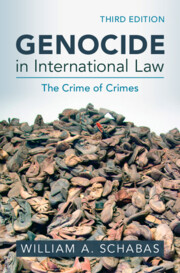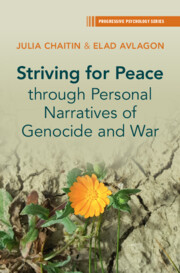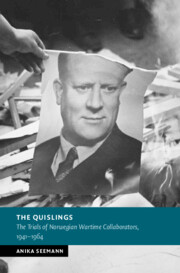151 results
Introduction
-
- Book:
- Genocide in International Law
- Published online:
- 14 March 2025
- Print publication:
- 03 April 2025, pp 1-13
-
- Chapter
- Export citation
1 - Origins of the Legal Prohibition of Genocide
-
- Book:
- Genocide in International Law
- Published online:
- 14 March 2025
- Print publication:
- 03 April 2025, pp 14-42
-
- Chapter
- Export citation

Genocide in International Law
- The Crime of Crimes
-
- Published online:
- 14 March 2025
- Print publication:
- 03 April 2025

Striving for Peace through Personal Narratives of Genocide and War
-
- Published online:
- 22 February 2025
- Print publication:
- 13 February 2025
Chapter 4 - Conceptualizations of Positive Peace and Reconciliation
- from Part I - Theoretical Background of the Book
-
- Book:
- Striving for Peace through Personal Narratives of Genocide and War
- Published online:
- 22 February 2025
- Print publication:
- 13 February 2025, pp 60-79
-
- Chapter
- Export citation
Chapter 3 - Coping, or Not, with Genocide and War
- from Part I - Theoretical Background of the Book
-
- Book:
- Striving for Peace through Personal Narratives of Genocide and War
- Published online:
- 22 February 2025
- Print publication:
- 13 February 2025, pp 41-59
-
- Chapter
- Export citation
Chapter 6 - Personal Narratives Connected to the Holocaust
- from Part II - Personal Narratives in the Contexts of the Holocaust, Israeli–Palestinian Conflict, and Internal Israeli Divisions
-
- Book:
- Striving for Peace through Personal Narratives of Genocide and War
- Published online:
- 22 February 2025
- Print publication:
- 13 February 2025, pp 89-106
-
- Chapter
- Export citation
Chapter 2 - Collective Identity, Perceptions of the “Enemy,” and Personal Narratives
- from Part I - Theoretical Background of the Book
-
- Book:
- Striving for Peace through Personal Narratives of Genocide and War
- Published online:
- 22 February 2025
- Print publication:
- 13 February 2025, pp 23-40
-
- Chapter
- Export citation
Chapter 5 - Limitation
-
- Book:
- The Quislings
- Published online:
- 12 December 2024
- Print publication:
- 19 December 2024, pp 190-225
-
- Chapter
- Export citation

The Quislings
- The Trials of Norwegian Wartime Collaborators, 1941–1964
-
- Published online:
- 12 December 2024
- Print publication:
- 19 December 2024

An Extraordinary Chinese Translation of Holocaust Testimony
-
- Published online:
- 25 November 2024
- Print publication:
- 09 January 2025
-
- Element
- Export citation

Profits and Persecution
- German Big Business in the Nazi Economy and the Holocaust
-
- Published online:
- 22 November 2024
- Print publication:
- 30 January 2025
10 - The Abyss
- from Part IV - A Lost Homeland: 1930–2000
-
- Book:
- Germany through Jewish Eyes
- Published online:
- 14 November 2024
- Print publication:
- 21 November 2024, pp 165-182
-
- Chapter
- Export citation

Germany through Jewish Eyes
- A History from the Eighteenth Century to the Present
-
- Published online:
- 14 November 2024
- Print publication:
- 21 November 2024
18 - Yiddish
- from Part III - Multilingualism in Britain and Ireland: Minority Languages
-
-
- Book:
- Language in Britain and Ireland
- Published online:
- 17 October 2024
- Print publication:
- 31 October 2024, pp 413-424
-
- Chapter
- Export citation
4 - Racism in Hitler’s Shadow
- from Part II - Kicking out the Turks
-
- Book:
- Foreign in Two Homelands
- Published online:
- 31 August 2024
- Print publication:
- 31 October 2024, pp 177-226
-
- Chapter
-
- You have access
- Open access
- HTML
- Export citation
7 - From World War I to the Holocaust
- from Part III - 1800 to the Present Day
-
-
- Book:
- A Documentary History of Jewish–Christian Relations
- Published online:
- 03 October 2024
- Print publication:
- 17 October 2024, pp 341-396
-
- Chapter
- Export citation
Memory Wars and Emotional Politics: “Feel Good” Holocaust Appropriation in Central Europe
-
- Journal:
- Nationalities Papers / Volume 53 / Issue 2 / March 2025
- Published online by Cambridge University Press:
- 14 October 2024, pp. 335-353
-
- Article
-
- You have access
- Open access
- HTML
- Export citation
The Impact of a Study Trip to Auschwitz: Place-based Learning for Bioethics Education and Professional Identity Formation
-
- Journal:
- Cambridge Quarterly of Healthcare Ethics , First View
- Published online by Cambridge University Press:
- 07 October 2024, pp. 1-11
-
- Article
-
- You have access
- Open access
- HTML
- Export citation

A Documentary History of Jewish–Christian Relations
- From Antiquity to the Present Day
-
- Published online:
- 03 October 2024
- Print publication:
- 17 October 2024


